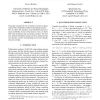Free Online Productivity Tools
i2Speak
i2Symbol
i2OCR
iTex2Img
iWeb2Print
iWeb2Shot
i2Type
iPdf2Split
iPdf2Merge
i2Bopomofo
i2Arabic
i2Style
i2Image
i2PDF
iLatex2Rtf
Sci2ools
ICIP
2005
IEEE
2005
IEEE
Minmax strategies for QIM watermarking subject to attacks with memory
This paper examines the role of attacker’s memory in Quantization Index Modulation (QIM) watermarking systems. First we derive the attacker’s noise distribution that maximizes probability of error of the detector. Next, we derive QIM code parameters that are minmax optimal. The minmax optimal embedding strategy involves randomized lattice rotations, and the corresponding worst noise distributions are isotropic.
Attacker’s Memory | Attacker’s Noise Distribution | ICIP 2005 | Image Processing | Quantization Index Modulation |
| Added | 24 Jun 2010 |
| Updated | 24 Jun 2010 |
| Type | Conference |
| Year | 2005 |
| Where | ICIP |
| Authors | Pierre Moulin, Anil Kumar Goteti |
Comments (0)

